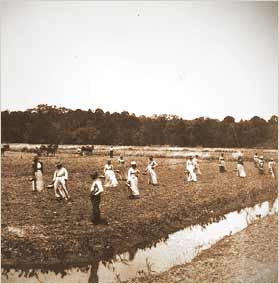RICE PLANTATION HISTORY
For over 4,000 years man has grown and consumed rice. Probably originating in Southeast Asia; the Moors brought it to Spain in the 8th century; then in 1609, English colonists tried growing it in Virginia. The beginnings of rice in South Carolina is uncertain but at least two theories persist.
The first has Dr. Henry Woodard obtaining Madagascar rice from Captain John Turner and introducing it before 1685; the second has the treasurer of the East India Company sending a bag of seed rice to Carolina in 1696 when the colonial assembly designated rice as one of the commodities that would be used to pay the annual quit rent tax.
By 1718, South Carolinians were exporting 6,773 barrels of rice, each weighing 350 lbs., to England and 2,333 barrels to other colonies.
Originally, Carolinians grew rice on dry land, but early in the eighteenth century, cultivation spread to swampy fresh water areas. By 1748, some planters were damming rain or creek water into reserves to systematically flood their rice fields. In 1758, McKewn Johnstone of Winyah Bay is said to have become the first to use the power of the tides to flood his rice fields with river water. By 1783, Gideon Dupont of St. James Goose Creek had perfected the tidal culture of rice. This proved to be a breakthrough that led not only to the more efficient cultivation of the crop, but also to higher yields requiring less labor.
With higher yields came a demand for milling, which was met a year or two earlier when Jonathan Lucas built the state's first water-driven rice mill on the Santee River. Other tidal-driven mills followed, and in 1817 he and his son built the first steam-driven mill in Charleston.
The cultivation of rice required huge capital investments. Planters needed a skilled work force to clear swamps, build and maintain a system of dykes and to plant, cultivate, harvest and process the crop. In order to meet those demands, the planters purchased slaves. Thus, the growth of the Carolina rice culture played an important part in the increase of the slave population. For example, in the first half of the nineteenth century in the Georgetown District slaves made up over eighty-five percent of the population.
Until the 1850's rice reigned supreme. But large-scale rice production was limited to tidal marshes and inland swamps, while cotton became profitable statewide after the invention of the cotton gin. Rice played an important part in the cross culturation of Carolina and made a few hundred planters extremely wealthy.
BACK TO TOP



